-
Welcome back Guest! Did you know you can mentor other members here at H-M? If not, please check out our Relaunch of Hobby Machinist Mentoring Program!
You are using an out of date browser. It may not display this or other websites correctly.
You should upgrade or use an alternative browser.
You should upgrade or use an alternative browser.
- Joined
- Jul 10, 2013
- Messages
- 1,191
Good question. Let's see if I can give you a good answer. It is a pin of a weaker material. A hole is in the shaft and a connecting hub. A pin is press fit so that the hub and shaft can rotate together. If there is too much force, the pin will break and saves the rest of the machinery. Then all you need to do is replace the pin. It is like a fuse in an electrical circuit. I hope that makes sense.
@ttabbal is there any reason for this: "that it's not commonly done" ?
Just because the "proper" way is on a mill with an indexer. It's more setup on the lathe and usually less accurate.
- Joined
- Nov 23, 2014
- Messages
- 2,609
Hi Chris,
I've cut a couple dozen gears over the years but have done it on a vertical mill, not a lathe. More typically they are done on a horizontal mill with an arbor supporting the cutter on either end for stability. But I've been successful with the set up shown below.
Not that it couldn't be done on a lathe, but it'd be a challenge. The biggest hurdle would be indexing the blank for each tooth. I could imagine setting a rotary table on your cross slide, the gear blank would be flat to the world. You'd have to come up with some way to get the center of the blank on the cutter's center line. Set the longitudinal position on center of the blank and lock it in place, use the cross feed to advance the cut. Problem would be moving the blank up/down to complete the cut through the face of the blank. Otherwise you'd just be plunging the involute cutter in and making a worm gear of sorts (tooth profile would be on a radius equal the the cutter diameter).
I bought a number of MOD pitch involute cutters from eBay seller mhestore2009 with very good results. They were under $12 delivered from Hong Kong. There are a couple of links below to some gear reference web site so you can calculate the MOD pitch of your gears, blank OD, etc.
Sounds like your gears are also keyed since they are driving the gear train. So most likely have broached keyways too. You could broach the keyway on your lathe with a HSS bit and a boring bar. I used a metric broach in my example below. I didn't have the proper bushing for the metric gear ID, so had to make a bushing too.
Not to be discouraging, but the best advise was given above to just buy the replacement gears. Gear cutting starts getting into mostly milling machine work and more expensive tooling. It's well within the capabilities of average hobby machinists (that's me, no formal training but pretty good at figuring out how/why stuff works). Just get ready to spend many $100's to replace one or two gears.
Bruce
https://khkgears.net/new/gear_knowledge/gear_technical_reference/calculation_gear_dimensions.html
https://www.technobotsonline.com/gear-size-calculator.html
Gear blank in L&W dividing head
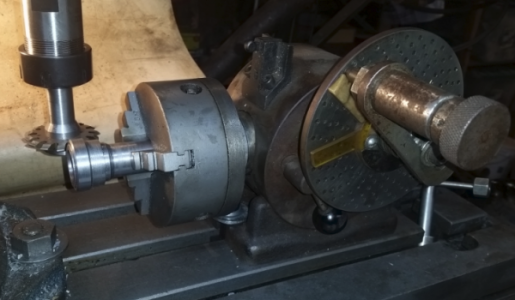
Making the final pass
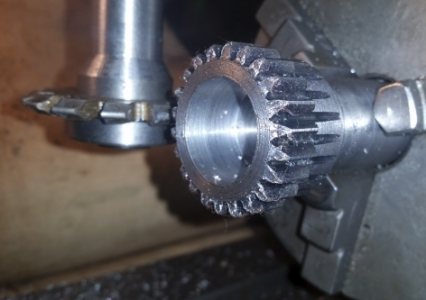
Shop made arbor (metric ID on the involute cutter)
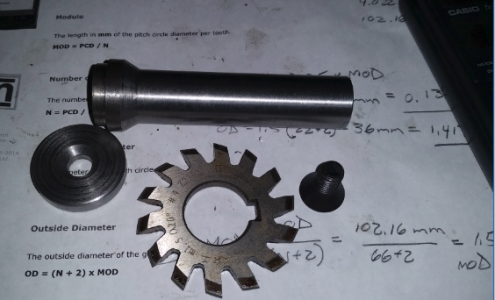
Finishing up the gear on the lathe
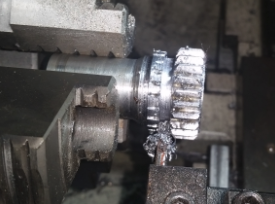
Broaching the gear keyway
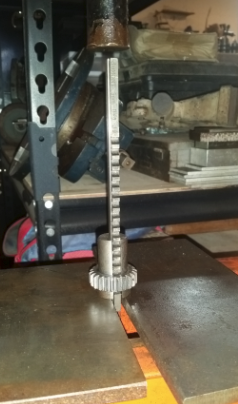
I've cut a couple dozen gears over the years but have done it on a vertical mill, not a lathe. More typically they are done on a horizontal mill with an arbor supporting the cutter on either end for stability. But I've been successful with the set up shown below.
Not that it couldn't be done on a lathe, but it'd be a challenge. The biggest hurdle would be indexing the blank for each tooth. I could imagine setting a rotary table on your cross slide, the gear blank would be flat to the world. You'd have to come up with some way to get the center of the blank on the cutter's center line. Set the longitudinal position on center of the blank and lock it in place, use the cross feed to advance the cut. Problem would be moving the blank up/down to complete the cut through the face of the blank. Otherwise you'd just be plunging the involute cutter in and making a worm gear of sorts (tooth profile would be on a radius equal the the cutter diameter).
I bought a number of MOD pitch involute cutters from eBay seller mhestore2009 with very good results. They were under $12 delivered from Hong Kong. There are a couple of links below to some gear reference web site so you can calculate the MOD pitch of your gears, blank OD, etc.
Sounds like your gears are also keyed since they are driving the gear train. So most likely have broached keyways too. You could broach the keyway on your lathe with a HSS bit and a boring bar. I used a metric broach in my example below. I didn't have the proper bushing for the metric gear ID, so had to make a bushing too.
Not to be discouraging, but the best advise was given above to just buy the replacement gears. Gear cutting starts getting into mostly milling machine work and more expensive tooling. It's well within the capabilities of average hobby machinists (that's me, no formal training but pretty good at figuring out how/why stuff works). Just get ready to spend many $100's to replace one or two gears.
Bruce
https://khkgears.net/new/gear_knowledge/gear_technical_reference/calculation_gear_dimensions.html
https://www.technobotsonline.com/gear-size-calculator.html
Gear blank in L&W dividing head

Making the final pass

Shop made arbor (metric ID on the involute cutter)

Finishing up the gear on the lathe

Broaching the gear keyway

Last edited:
- Joined
- Aug 7, 2018
- Messages
- 668
Hi Guys,
I had a similar dilemma when I managed to seize a slitting saw in some aluminum on the mill. The supplier wanted silly money for a pair of plastic gears, which I found out later were not actually bored central and ran eccentrically, causing a rhythmic noise that varied with speed when running.
So I made steel gears to replace them.
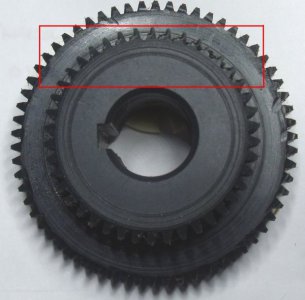
This is the original plastic gear. The damaged teeth can be seen at the top.
You can also see that the teeth are not all the same size around the large gear.
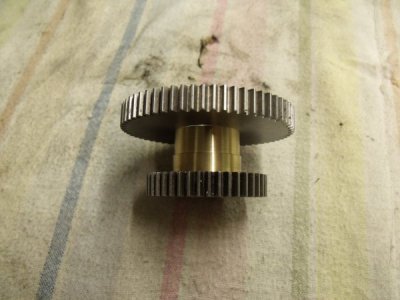
This is the new gear. When this picture was taken the large gear was waiting to be pressed onto the bronze sleeve.
I had a similar dilemma when I managed to seize a slitting saw in some aluminum on the mill. The supplier wanted silly money for a pair of plastic gears, which I found out later were not actually bored central and ran eccentrically, causing a rhythmic noise that varied with speed when running.
So I made steel gears to replace them.

This is the original plastic gear. The damaged teeth can be seen at the top.
You can also see that the teeth are not all the same size around the large gear.

This is the new gear. When this picture was taken the large gear was waiting to be pressed onto the bronze sleeve.
- Joined
- May 16, 2016
- Messages
- 1,701
that makes perfect sense!
They must be sacrificial gears, I switched it from high to low whilst it was running.... STUPID idiotic mistake on my part....
I'll buy the ones from this source now
I did assume that they where just cheap since the threading gears beneath them are also plastic and I've seen those been replaced in multiple places online but I have never seen these been replaced...
I am VERY interested in being able to create/hob gears on lathe though, what would be involved ?
I've seen indexing wheels and hobbing / flywheel cutter, to be honest I've seen LOADS of different setups for gear cutting on the lathe but I haven't been able to find what seems like a tutorial on how to do it from scratch...
Nor what the pro's/ cons of each method are...
Thank you guys so much for pointing me in the right direction, I was about to make another stupid mistake!!!
If you really want to try your hand at cutting gears on a lathe google cutting spur gears on a lathe.
There are some you tube tutorials You could also try making some gears in aluminium,as long as you keep at least a couple of plastic ones in the set up you should be protected against breaking some expensive part. Also running plastic against metal should give a long life.
Think of replacing the gears that wear the most with metal and leave a few in plastic.
- Joined
- May 31, 2018
- Messages
- 184
If it were me I would stick with plastic gears externally as these are cheap, readily available, easy to replace, quiet and self lubricating.
I would concentrate on upgrading the Hi-Lo gear inside the headstock because when this goes it is a ball ache to replace because you've got to take the spindle bearings out which means a full strip down of the lathe to get access to it from underneath. If you upgrade this gear from plastic to metal then in the event of a failure it will be on the external plastic gears and not inside the headstock.
It is also a great opportunity to replace the stock bearings with tapered roller bearings which are much more rigid than the stock bearings - a very worth while upgrade IMO.
I would concentrate on upgrading the Hi-Lo gear inside the headstock because when this goes it is a ball ache to replace because you've got to take the spindle bearings out which means a full strip down of the lathe to get access to it from underneath. If you upgrade this gear from plastic to metal then in the event of a failure it will be on the external plastic gears and not inside the headstock.
It is also a great opportunity to replace the stock bearings with tapered roller bearings which are much more rigid than the stock bearings - a very worth while upgrade IMO.

